MXA’S 2012 KAWASAKI KX250F MOTOCROSS TEST: DUAL FUEL INJECTORS ARE THE FUTURE & KAWASAKI GOT THERE FIRST
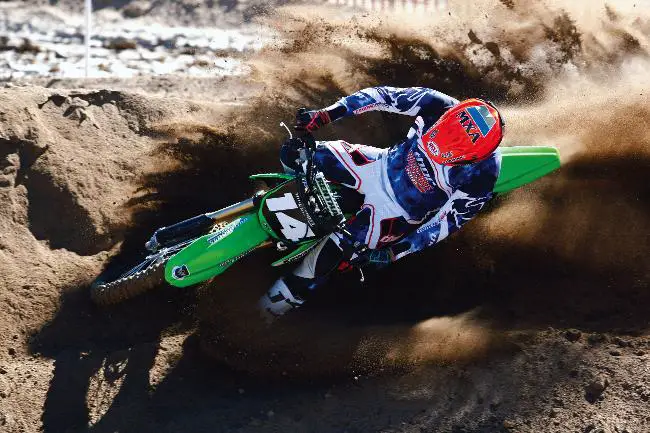
Q: FIRST AND FOREMOST, IS THE 2012 KAWASAKI KX250F BETTER THAN THE 2011 KX250F?
A: Yes, resoundingly so! Every MXA test rider, regardless of skill level, immediately fell in love with the 2012 Kawasaki KX250F. All it took was one ride to solidify our appreciation for what Kawasaki had done to the bike in a single model year. The 2011 KX250F boasted Showa’s radically new “Separate Function Fork” (SSF) design as well as fuel injection, but in reality, the green team was merely warming up the orchestra. For 2012, Kawasaki fine-tuned their masterpiece. The 2012 KX250F has garnered a standing ovation from the MXA wrecking crew. Bravo!
Q: WHAT SIGNIFICANT CHANGES WERE MADE TO THE 2012 KAWASAKI KX250F?
A: Kawasaki focused on three areas of concern:
(1) Dual Fuel-Injection system. Don’t confuse DFI with DFI. Say what? Last year, Kawasaki’s marketing department coined the term “Digital Fuel Injection” to differentiate their fuel-delivery system from electronic fuel injection (EFI). For 2012, Kawasaki kept the DFI acronym but changed the name of their fuel management program to “Dual Fuel Injection.” What’s the reasoning behind the updated nomenclature? It has to do with the secondary injector.
Kawasaki’s engineers are familiar with incorporating a secondary fuel injector into the equation. Having first used the technology in road racing, it was passed down to their production ZX-10R street bike. Finding success on the street side, the dual fuel-injection idea trickled down to the 2012 KX250F.

What does a secondary injector actually do? While the primary injector, located in the throttle body, delivers fuel from off-idle at 5000 rpm to 7000 rpm, the secondary injector eases in and delivers fuel from 7000 rpm up through 13,000 rpm. When the throttle is held wide open, the primary injector is shut (delivering zero fuel), and the secondary injector is completely open. The secondary injector is located in the air boot, and both injectors have the same spray capacity and four-hole configuration.
To complement the radical idea, Kawasaki updated the electronic control unit (ECU) to increase ignition power in order to run the dual-injector system. The 43mm Keihin throttle body has been fitted with a new seal between the air inlet port and throttle position sensor to prevent fuel entering from the upstream injector. The ECU bracket has also been changed to accommodate the new ECU.
(2) Engine. Over the years, the KX250F has been at the forefront of 250 four-stroke advancement, thanks in large part to Kawasaki’s relationship with the Pro Circuit race team. The 2012 KX250F is, in part, the byproduct of many hours spent in the Pro Circuit dyno room and on the professional racing circuit. Kawasaki utilizes Pro Circuit’s technology to boost power on their production bike. And so it is with the 2012 KX250F. The crankshaft, connecting rod, ACG stator and rotor have been revised. The crankshaft assembly features a balance factor of nearly 60 percent, which Kawasaki claims is on par with their factory race machines.
The material on the crankshaft web and connecting rod has been thickened, and the crankshaft pin has been strengthened. For enhanced long-term durability, the cylinder walls and piston have a nickel-plate coating. Kawasaki also updated the transmission for the umpteenth time. A slightly shorter stroke of the shift fork and solid shift rods are supposed to provide a more positive feel while shifting through the gears.
(3) Suspension. Last year’s KX250F came equipped with the forward-thinking Showa SFF. The concept was simple: use an extra-stiff fork spring in the right fork leg, while the left fork leg takes care of the piston-rod damper, air chamber and bulk of the fork oil. The design made it easier to work on the forks and allowed for ride-height adjustment in the front end. The MXA wrecking crew was pleased with the Showa SFF units?except for one caveat; the fork spring rate was too soft for serious racing. Kawasaki granted our wish in 2012 by swapping out last year’s 0.93 kg/mm spring for a 0.97 kg/mm unit. They also added a longer top-out spring with a reduced spring rate and tinkered with the valving.
In order to match the fork change, they also went to a stiffer shock spring, moving from a 5.2 kg/mm to a 5.4 kg/mm. Additionally, Kawasaki focused on increasing setting flexibility and offering smooth and steady action in the shock. They did so by decreasing the size of the hole in the low-speed and high-speed compression damping restrictor. The piston-rod end was also lengthened by 3mm, and the piston-rod end restrictor diameter was decreased. Borrowing an update from the 2012 Kawasaki KX450F, the 250F’s tie-rod arm is thinner for improved rear-wheel traction and smoother suspension performance.
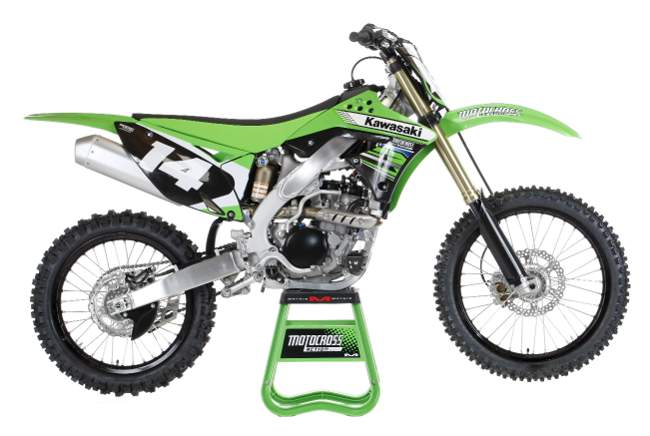
2012 Kawasaki KX250F: The 2012 KX250F boasts dual fuel injectors, improved power and stiffer suspension settings. The KX250F is bred for racing.
Q: IS THE KX250F’S DUAL-INJECTOR DESIGN A BIG DEAL?
A: Is the Pope holy? You betcha! Dual injector systems are old hat in the street bike industry, but in the motocross circles, it’s a huge deal. Why? In layman’s terms, it might just convert the carburetor faithful over to the land of butterfly valves and fuel pumps. Fuel injection is here to stay. The time of the carburetor has passed. Aside from a few holdouts (the KTM 450SXF and Yamaha YZ250F), every motocross bike is now equipped with EFI. But only the KX250F has EFI times two.
The development of any new technology comes with growing pains. Electronic fuel injection ruined the powerband of several 250 four-strokes in 2011, including the Kawasaki KX250F. EFI neutered the awesome hit the KX250F had become known for, essentially turning an untamed lion into a sheep on Quaaludes. Kawasaki knew the dangers of switching to EFI. In fact, they shelved the technology during the 2010 model testing due to unsatisfactory performance. Kawasaki took the leap in 2011, but the Keihin system was missing something. Enter the secondary fuel injector.
On last year’s fuel-injection system, the injector was designed to feed fuel into the engine. Only instead of being able to supply the right amount of fuel throughout the entire spread of the powerband, the injector couldn’t keep up. Adding a secondary injector that tapers the rate of fuel delivery into the engine from 7000 rpm on up allows the second dose of fuel on heavy acceleration to increase high-rpm power and over-rev. It’s the cat’s meow.
Q: HOW DOES THE 2012 KAWASAKI KX250F COMPARE TO LAST YEAR’S MODEL ON THE DYNO?
A: The 2012 Kawasaki KX250F romps the 2011 engine. It is, without question, the most powerful KX250F that we have ever put through our dyno. We were so baffled by the horsepower output that we were sure the dyno was broken. It wasn’t.
Maximum horsepower on our 2012 KX250F was 39.55 ponies at 12,800 rpm. Maximum torque was 20.33 foot-pounds. For comparison, our 2011 KX250F reached 37.30 horsepower at 12,600 rpm and produced 18.90 foot-pounds of torque. In the course of three years, Kawasaki’s engineers have managed to squeeze three more horsepower out of the KX250F. If this were baseball, we’d accuse them of using performance-enhancing drugs, because there’s such huge disparity in output. Instead, we will congratulate Kawasaki for developing a blazing-fast engine on the dyno.
As for the KX250F dyno curve, the 2012 model is two horsepower better from 6000 rpm until around 13,000 rpm. At high rpm, the 2012 KX250F holds strong, while the 2011 wavers and then falls off significantly (as much as four horsepower).
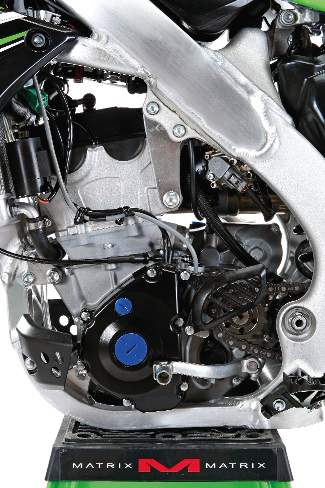 |
| Dyno breaker: Unbelievably the 2012 KX250F pumped out 39.55 horsepower (up two ponies from last year). The duel fuel injectors and revised camshaft make the green machine howl.
|
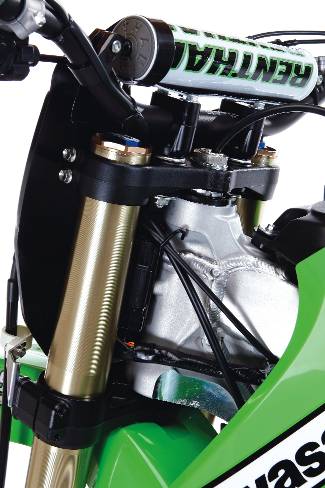 |
| Chinks in the armor: Aside from the cranky shifting, the triple clamps are in need of an offset change. |
Q: HOW FAST IS THE 2012 KAWASAKI KX250F?
A: As excited as we were about the dyno run, we weren’t fooled into assuming that the 2012 KX250F would be a dynamo on the track. We’ve tested our fair share of dyno queens that turned out to be slugs on the track. However, the 2012 Kawasaki KX250F is not in this category. Why? The bike is a rocket ship! It blasts down straightaways with fervor and refuses to nose over until well past reasonable shifting points. From the bottom end, the engine snaps to attention and quickly climbs up the horsepower ladder, shrieking through the midrange and into the top end. Over-rev is plentiful, and the powerband is merciful enough for every skill level. It’s best to grab gears and hold on, because the engine isn’t weak at any particular point in the powerband.
Last year’s fuel-injected engine can’t be compared to the 2012 powerplant, because the two are so very different. Whereas last year’s powerband was electric, this year’s is explosive. We figured that fuel injection had led to the demise of the KX250F, but we were wrong. The secondary fuel injector saved it and helped bring the KX250F back to its rightful spot at the top of the 250 four-stroke heap.
Q: DOES THE 2012 KAWASAKI KX250F PASS THE SOUND TESTS?
A: Either Kawasaki’s engineers are deaf, or they simply don’t care about sound ordinances. The KX250F is the perennial loud mouth of the class. Last year, the bike was decently quiet in the AMA sound test, but it bombed the FIM two-meter-max test. The 2012 KX250F belched out 95.2 decibels in the AMA test (barely quiet enough to pass) and rang our ears at 118.5 decibels in the FIM test (3-1/2 decibels over the limit). Don’t expect to make your neighbors happy if you ride within bombing distance of them.
Q: WHAT IS THE SUGGESTED RETAIL PRICE OF THE 2012 KX250F?
A: The KX250F retails for $7399. For comparison, the 2012 KTM 250SXF retails for $7699, and the Suzuki RM-Z250 for $7399.
Q: HAS OUR OPINION CHANGED ON THE SHOWA SFF FORKS?
A: Yes. Last year, we admired the Showa SFF fork design, as the forks had the ability to work well in a plethora of situations. However, we were displeased with the overly soft 0.93 kg/mm spring rate and traded up to a 0.97 kg/mm spring. Kawasaki listened to our complaint and upped the stock spring rate on the 2012 model. So, yes, our opinion has changed on the Showa SFF forks, but in a positive way.
The stiffer forks hold up in the stroke and don’t immediately blast through their travel over small ripples on the track. Kawasaki also raised the oil height?374cc compared to 357cc in 2011?to firm up the feel of the forks. The 2012 setup is geared toward serious racers and might be too stiff for lighter and/or conservative riders. Given our druthers, we’d prefer to have the forks on the stiff side and dial them in. That’s exactly what we did on the 2012 KX250F.
Q: HOW DOES THE 2012 KX250F HANDLE?
A: Aside from a thinner pull-rod arm, Kawasaki avoided addressing their handling woes with the 2012 KX250F. The KX250F has long suffered from a vague feel at turn-in, and the rear end wallows under acceleration. Truth be told, Kawasaki attempted to address their handling issues last year by reducing the fork offset to 22.5mm (down from 23.5mm) and changing the engine-mount brackets. The 2011 and 2012 models handle identically. Test riders couldn’t discern between last year’s pull rod and the new thinner design.
All of this leads us to the question at hand: how does the 2012 KX250F handle? Although not the sharpest-handling machine in the class (that distinction belongs to the Suzuki RM-Z250), the KX250F can hold its own once the ride height and clickers are dialed in. Every tester would have preferred that Kawasaki solved the riddles of the vague feeling at turn-in and wallowing under acceleration, but the handling is still decent. Just don’t expect to cut the tightest line around the track.
Q: WHAT ARE MXA’S RECOMMENDED KAWASAKI KX250F FORK SETTINGS?
A: Here is what the MXA wrecking crew ran in its 2012 Kawasaki KX250F (stock settings are in parentheses):
Spring rate: 0.97 kg/mm
Oil height: 374cc in left leg, 205cc in right leg
Compression: 10 clicks out (8 clicks out)
Rebound: 9 clicks out (10 clicks out)
Preload adjuster: 16 clicks in
Fork leg height : 5mm up
Notes: The KX250F’s handling traits are dependent on ride height. Too much ride height yields a vague feeling at turn-in. To measure ride height, have the rider sit on the bike. Measure from the bottom of the right fork guard to the dust seal.
Q: WHAT ARE MXA’S RECOMMENDED KAWASAKI KX250F SHOCK SETTINGS?
A: Here is what the MXA wrecking crew ran in its 2012 Kawasaki KX250F (stock settings are in parentheses):
Spring rate: 5.4 kg/mm
Race sag: 100mm
Hi-compression: 1-1/4 turns out (1-1/2 turns out)
Lo-compression: 10 clicks out (11 clicks out)
Rebound: 10 clicks out (11 clicks out)
Notes: We think that the KX250F works best with the low-speed compression turned in while using the high-speed to adjust the ride height at speed.
Q: WHAT DID WE HATE?
A: The hate list:
(1) Clutch. A Kawasaki clutch burns up faster than a car in “Mad Max.” The stock clutch lasted all of a few hours. Stay away from the clutch, or buy stiffer clutch springs; it’s your choice.
(2) Shifting. The shifting mechanism is public enemy number one on the 2012 KX250F, just as it was on the 2011 model, 2010 model, ad nauseam. The 2012 KX250F often refuses to shift under heavy acceleration. It can lead to frustration down long straights.
(3) Brakes. We would think that a blazing-fast engine and strong brakes would go hand in hand. Kawasaki proves that theory wrong. You will want to invest in an oversize front brake rotor, or at the very least in a Bible, because you’ll have to pray to get the KX250F to stop.
(4) Annoyances. The vulcanized grips need to go away, as does the cotter pin on the rear axle and black rims. These parts don’t affect performance, but they raise our blood pressure every time we replace a grip, remove the rear axle or shine up the pockmarked rims. We complain about these nuisances every year, but Kawasaki’s lawyers and designers keep turning a deaf ear.
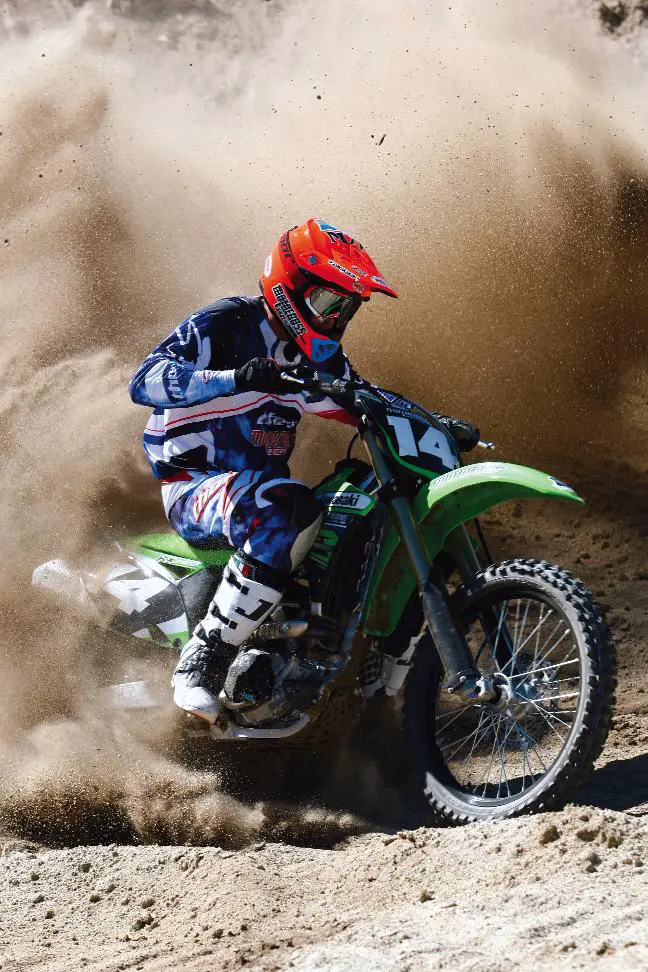
Twist and shout: MXA test riders raved about the broad powerband and stiffer suspension settings. The 2012 KX250F is the top candidate for MXA’s coveted 250 Four-Stroke of the Year award. Yes, it’s that good.
Q: WHAT DID WE LIKE?
A: The like list:
(1) Engine. Can we get a “hallelujah!”? The 2012 KX250F powerplant hauls the mail, thanks to the secondary upstream injector and race-ready engine updates. We’re going out on a limb by saying this is the best production 250 four-stroke engine that we have ever tested?and that’s making a statement. It’s a rocket on the dyno and rips around the track. The KX250F engine is so good that it would make Chuck Norris cry, and that’s nearly impossible.
(2) Upstream injector. Kawasaki has set the benchmark with their all-new dual fuel-injection system. The secondary injector boosts top-end power, while the downstream injector helps deliver bottom-end hit. This is the first fuel-injected 250 four-stroke with a powerband that mirrors a carbureted bike.
(3) Suspension. We were satisfied with the performance of the Showa units last year but needed a stiffer fork spring. Kawasaki heeded our call and beefed up the spring rate on the SFF fork. Bravo!
(4) Gearing. Last year, Kawasaki figured out their gearing problems, and the 2012 KX250F is also geared properly. The 13/50 combination works well on all but very tight tracks.
Q: WHAT DO WE REALLY THINK?
A: Over the past six years, the Kawasaki KX250F has won MXA‘s coveted 250 four-stroke shootout four times. The Kawasaki KX250F has earned the crown, thanks in part to an excellent powerband, decent suspension and handling that was good enough to get around the track. Guess what? The 2012 model has the distinction of being the best KX250F engine that we have ever tested. Add in the fact that Kawasaki dialed in the spring rates and that’s a recipe for success. The writing is on the wall, folks. The 2012 Kawasaki KX250F is a world-beater.






Comments are closed.